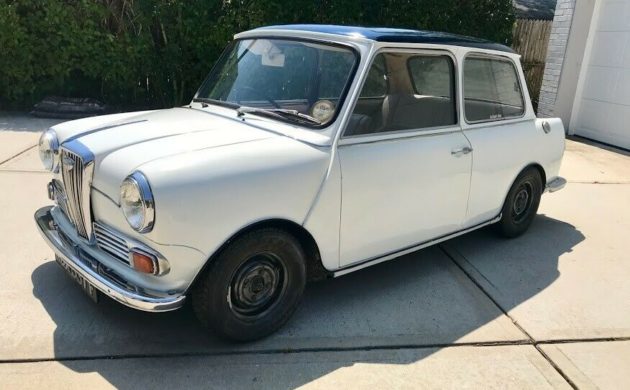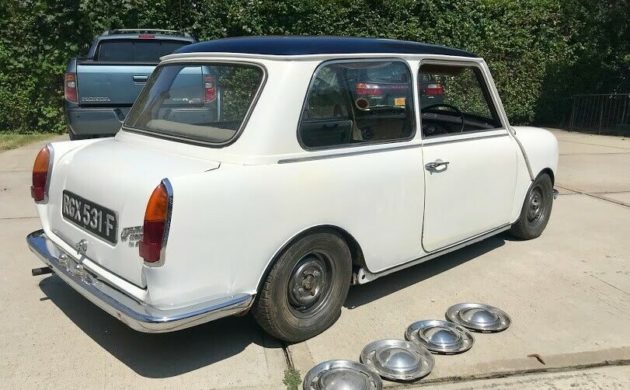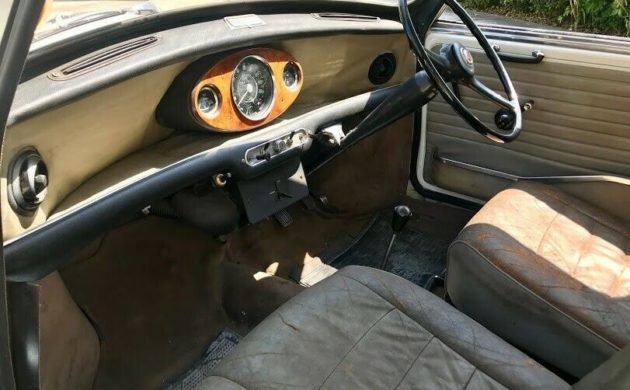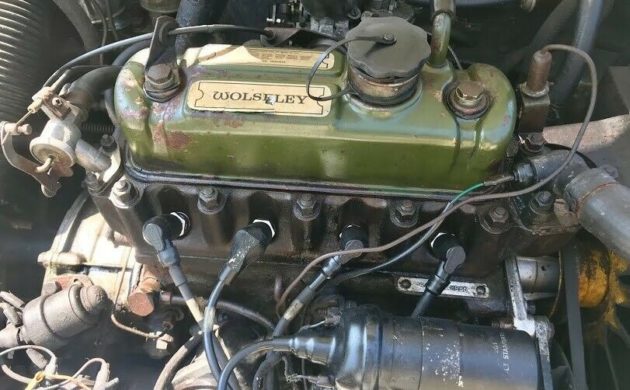The original Mini was designed to be inexpensive transport for the masses, and it managed to become both a sales success and a motoring legend. Of course, a little luxury goes a long way, and the humble Mini managed to spawn a couple of variants aimed at the person who desired a car that was a bit more exclusive. One of these variants was the Wolseley Hornet, which sold between 1961 and 1969. This Hornet Mk III version rolled off the line in 1968, and while it could definitely do with some refreshing, it is a car that could conceivably be driven and enjoyed largely as it currently stands. The Wolseley is located in Brooklyn, New York, and has been listed for sale here on eBay. The BIN for this little Brit has been set at $11,499, but the option is available to make an offer.
The owner is a bit tongue-in-cheek when he discusses rust issues in the Hornet. He doesn’t mention any specific problems but does point out that “British cars come with rust from the factory.” Whether this is strictly accurate would be questionable, but rust could be an issue with some of these cars. This one looks very promising, but I would still like to get a good look around under the vehicle. While the Hornet was very obviously based on the Mini, the body was extended by approximately 10 inches. All of this additional length went into the rear quarter panels, increasing useable trunk space and allowing the vehicle to wear a small set of fins. The front also underwent some cosmetic changes, and in this case, the vehicle wears a larger and more upright grille that features an illuminated “Wolseley” badge. In addition, the Mk III version of the Hornet also saw the introduction of wind-up windows in place of the previous sliding versions. The paint and trim on this Hornet generally look to be quite good, although I believe that both would benefit from the application of some polish. The glass also looks fine, although the fact that it is common between the regular Mini and the Hornet means that sourcing any replacement glass is pretty easy.
Whilst the Hornet brought a touch of luxury to the market, the final offering was far closer to its Mini cousin in equipment levels than it was to any offering from Cadillac. Essentially, the gauges received a timber surround, fresh air vents suddenly appeared at either side of the dash, but the big-ticket item was the inclusion of leather upholstery, which did have a positive impact on vehicle comfort. The vast majority of the interior trim actually looks reasonably good, and I can’t see any real reason why it couldn’t see service for many years to come. The biggest problem is going to revolve around the leather on the seats because that has deteriorated quite badly. I’ve done a bit of research, and replacement covers are available. This is where potential owners will need to swallow pretty hard because, for such a small car, the average price of $1,500 for a full set of seat covers is pretty big. I mean, it would be possible to find alternatives that aren’t leather, but that means that the car loses what is almost certainly its most important interior luxury feature.
Under the hood of the Hornet, we find the Mini Cooper’s 998cc 4-cylinder engine, producing 38hp. It really is standard Mini fare, with the transverse engine sending its power to the front wheels via a 4-speed manual transmission. The brakes received a marginal upgrade in the Hornet, although they were still drums all the way around. The biggest sticking point with the Hornet was that the additional body length also brought with it additional weight. We’re only talking about something in the vicinity of 100lbs, but when the donor car tipped the scales at a featherweight 1,279lbs, it really was noticeable. However, the Hornet was still a reasonable performer and also delivered pretty exceptional fuel economy. The owner of this Hornet states that it runs and drives, but that it will require some mechanical work. He mentions the fact that work is required on the brakes, and I would have no hesitation in making that a priority. Beyond that, he doesn’t mention anything specific. it’s also worth remembering that if an owner isn’t focused on complete originality, that there are plenty of affordable components that would allow them to reliably extract improved performance from their Lilliputian limo.
During its production life, a total of 28,455 Wolseley Hornets rolled off the production line. None were ever officially imported into the USA, meaning that the very few examples that exist on our roads today were privately imported by enthusiasts that were searching for something different. Due to the additional weight, the Hornet does lose-out a bit on performance when compared to the Mini, but the additional length actually makes for a more practical vehicle. The Mini has a strong following, but this car represents something a bit different. That makes it a British classic that is well worth a look.







What a “Honey” of a car! I wonder what it was that broke that requires attention?
Mr bean would love this, his teddy bear could have the whole seat to himself!
Another Mini.
Someone must have found a Cracker-Jack box full of them 😂
I should think that it’s about $9000 overpriced judging by the prices they fetch here in UK.
And still have to push it up hills.😂
You would be surprised at the prices these bring here if in good shape.
It’s too pretty. I wonder how much bondo it has…
Very cute, doesn’t look at all bad in the photographs.
Looks as if the suspension is depressurised and that can be tricky depending on what the reason is.
BMC also offered a Riley Elf,which was very similar.
Del! What did I say about those “And still have to push it up hills” remarks? 😂 I know you’re just trying to get my goat!
This car has the hydrolastic suspension, so just needs little pumping up, as they do lose a bit of pressure over time; it does not have the Cooper engine (note the single carb), but even the original 848cc engine would move the Mini along, smartly, if one didn’t mind doing a little rowing, but push it up a hill? Never. Unless Del’s hills are similar to the driveways like those that were made of concrete, in a very hilly, wooded section of the US, where the houses were on top of the hills, and the the top & bottom driveway angles were 45 degrees! God, how I wish I had bookmarked the site wtih those pictures.
The Elf was a prettier car, it seems to me. (Thanks for the reminder, Luke). On the leather seats: I don’t think anyone could improve on the comfort provided by the Cooper seats, and this comes from a guy who spent 25 hours, in January 1967, driving from Toronto to Chicago, through a snowstorm that closed down a major portion of North America. Last of all, there does not seem to be anything other than minor surface rust showing. Afterthought: by 1968, had they not already changed over to alternators? This may be a replacement engine on top of the original tranny.
😁😂🤣